This is not a horror story, but a story about horror.
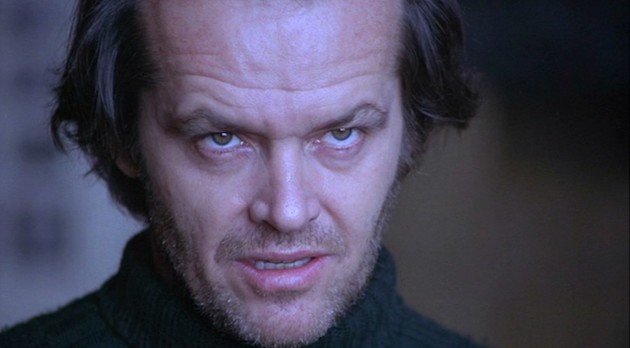 This is not a horror story, but a story about horror..
This is not a horror story, but a story about horror..
“You can move away from a stranger. You can’t move away from yourself”. In the “The Shining”, the monsters and ghosts are real and they live in us.
The obsession with the novel by Stephen King – taken to the big screen by Stanley Kubrick – has led some people to discover their darker side. Now the sequel of the book has been released – “Doctor Sleep”. In it Ewan McGregor plays the role of the little boy in the original film, now grown up.
With “The Shining” (1977), King went from being the “Master of Horror” to become the author of the “great American novel”. Similarly, Hitchcock, the “Master of Suspense”, if it had not been for certain French critics, “Vertigo” (1958) would have never been considered the best film in the history of cinema, demoting “Citizen Kane” (1941).
In 2003 the author of the Western Canon, Harold Bloom, dismissed the choice of King US National Book Foundation award, but now prestigious media outlets like The New Yorker or the New York Times Book Review are sing the praises of this author from Maine.
 The sequel of the book has been released. Ewan McGregor plays the role of the little boy in the original film, now grown up.
The sequel of the book has been released. Ewan McGregor plays the role of the little boy in the original film, now grown up. Stephen King is now fashionable, but for a long time he was considered to be a commercial author of dubious taste, who churned out books that were only fit for the crude entertainment of braindead adolescents.
I must confess that I was of the same opinion until I heard the renowned Argentinian author Rodrigo Fresán commending “The Shining” as a specimen of “the great American novel”, in his cultural column in the right-wing Spanish newspaper ABC. I then realized that I had never read one of King’s books to make my own opinion.
It was thanks to my friend Julio Martínez that I discovered King’s more sentimental side in nostalgic stories about lost childhood. As with films by Hitchcock – possibly the only name that comes to mind when people ask me for my favourite director –, I would not be able to say which is my favourite of King’s books or films.
Choosing between The Dead Zone, 22/11/63, It, The Shining, Joyland, or films like The Shawshanks Redemption, Dead Zone, The Green Mile, Stand By Me and The Shining would be hard.
THE BOOK OR THE FILM?
The Argentinian writer Rodrigo Fresán says that there are three types of spectators of Kubrick’s “The Shining” (1980): those who have only seen the film; those who have read the book and compare the two; and those like myself, who “went from the colourful darkness of the cinema to find shelter in the black and white of the text”, allowing ourselves to be led along the corridors of Hotel Overlook. I increasingly think that the hackneyed question of whether the film or the book is better makes no sense.
A book is not a film and a film is not a book. They are two different animals.
King hates Kubrick’s film because it is not his book. What few people know is that it isn’t his original story either. “The Shining” was born from a short story that the author of the “Red Badge of Courage”, Stephen Crane (1871–1900), published a few months before dying at the age of 28.
“The Blue Hotel” (1898) tells the story of something that happened to him in Lincoln (Nebraska). It is about a group, including a mentally disturbed person, that is cut off in a mountain resort hotel.
Rejected by the main magazines at the time, Harper’s and Collier’s, Crane published it in a book entitled “The Monster and Other Stories”. King knew of him as a literature professor who had influenced stories including Hemmingway’s “The Killers”, which borrowed The Swede’s name for its main character.
Kubrick was also familiar with Crane’s story, having worked on the series “Omnibus” when James Agee adapted it for television in 1953. They were in fact, therefore, both inspired by Crane’s short story, where the protagonist’s fears focus on the idea that a murder took place in one of the hotel rooms, after seeing the photo that the owner shows him of his dead daughter – coincidentally called Carrie, like King’s first novel taken to the screen by Brian De Palma.
And if this were not enough, the ending takes place in a luxurious bar, where The Swede is having a friendly chat with a waiter. All very familiar.
DANGEROUS ENMITIES
King wrote a cinematographic script for his own novel but this was rejected by Kubrick, who turned to another literature professor, Diane Johnson. She had written a book about four characters in a house in Sacramento. Not best pleased, in 1997 King did his own miniseries adaptation for television with his friend Mick Garris.
Kubrick saw the problem of taking such a long book to the normal length of a feature film. It would have lasted for four or five hours, which would have made it impractical for cinema distribution. As it was, 20 of the 140 minutes had to be cut for the European version.
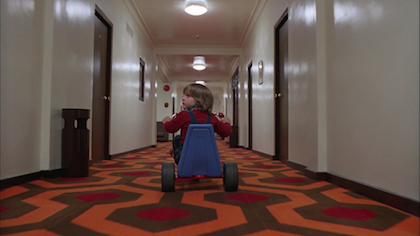 The movie is is a chronicle of a journey into the heart of darkness.
The movie is is a chronicle of a journey into the heart of darkness. When the original film was edited for video, the main character’s transition to madness is easier to observe. It also includes a psychiatrist who examines his son’s disorders in the style of “The Exorcist”, and various other cuts that make the story more understandable.
However, there are big differences with King’s novel, especially at the end. In the book there is no mention of the famous labyrinth, which is so central to the film. Kubrick also begins the story with the arrival at the hotel and we don’t know about anything that happens before.
Novel and film coincide in describing the main character, Jack Torrance (Jack Nicholson), as a troubled man. He is an ex-alcoholic, like King, who is trying to overcome his failure as a writer.
He uses his time working as the winter caretaker of the Overlook Hotel to write a new novel. He moves there with his wife Wendy (Shelley Duvall) and his son (Danny Lloyd), who he has abused in the past and who has developed an exceptional sensitivity, expressed through an imaginary friend on his index finger.
The film plays down this fantastical element, suggesting that the ghosts are in his mind. That is one of the criticisms made by King.
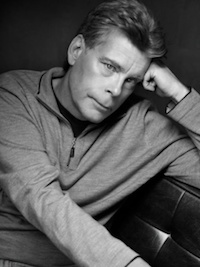 Stephen King told Rolling Stone how he has become a believer.
Stephen King told Rolling Stone how he has become a believer.ROOM 237
The hotel exterior and the inspiration for its interior decoration comes from the Timberlake Hotel in Colorado, which Kubrick turned into a giant set where he repeated take after take – with a record of 147 takes for one conversation. His perfectionism extended to technical experimentation.
After having filmed by candlelight for the first time in “Barry Lyndon” (1975), he filmed almost the whole of “The Shining” with a new camera, the Steady-cam, which allowed shooting without rails. The delay that all this caused was compounded by a fire that broke out on set in January 1979.
The film has been given an element of mystery by Kubrick’s obsession for numbers and geometry. In addition to the repeated use of the number 42, he changes the room number 217, for a number that does not exist, 237.
It may have simply been at the request of the owner, who may not have wanted a cursed room in his hotel. The fact is that the number has led to a whole series of speculations.
It is the title of a documentary on various conspiracy theories thrown up by the film and upheld with great coherence using interviews and scenes as evidence to support the most ludicrous interpretations.
In the feature film directed by Rodney Ascher, “Room 237” (2012), we find out that the hotel that inspired King – the Stanley of Estes Park, Colorado –, was built on a tract of land linked to the genocide of the Navajo people.
This would explain the recurring references to native Indians. Another theory puts Kubrick behind the supposed moon landing hoax, with the film allegedly providing clues.
There’s another theory that links “The Shining” with the Holocaust, playing with numbers such as 42, the date of the Nazi’s “Final Solution”, as well as hidden words and symbols.
Above all, the most frequent interpretation of the film hinges on the myth of Theseus and the Minotaur, but in general the documentary suggests that any wacky theory is possible.
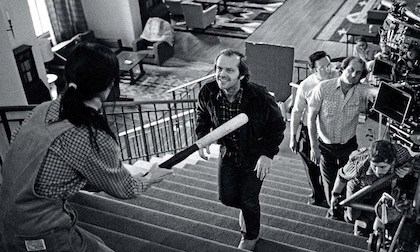 Kubrick recreated the interior of a hotel in Colorado.
Kubrick recreated the interior of a hotel in Colorado.OUR PAST FOLLOWS US
What is clear both in the book and in the film, is that our past follows us. Professor Simon Roy, a Canadian born in 1968, can’t write objectively about this story without identifying himself with the danger that Danny is in.
Roy saw the film when he was 11 years old and when he heard the voice of cook Halloran – dubbed into French – communicating telepathically with Danny, he felt that he was talking to him.
He did not have the courage to watch it again until he was a teenager, at around the same time as his mother started to try to commit suicide. The first time was when he was 16, but she did not manage it until 2013, when she died of an overdose.
Roy’s mother was traumatised by her psychopathic grandfather, not unlike Jack Torrance. He murdered her grandmother by bludgeoning her to death with a hammer. Her aunt then disappeared in mysterious circumstances.
Just like the dead girls in the hotel, she was her mother’s twin sister. This Quebecois literature professor has seen the film 42 times, the number that is repeated over and over throughout the film.
His book is something between an essay on cinema, a sociological treatise, a compilation of interesting facts, and a personal memoir. Published first in 2014, “Kubrick Red” is a chronicle of a journey into the heart of darkness.
As some have said, this is not a horror story, but a story about horror. The film creates the possibility that the manifestations may not be real but only ghosts in Jack’s delirious mind – unleashed by his alcoholism and madness – or in Danny’s childhood fantasies.
Kubrick told Michel Ciment that he had liked the book because of the way that King entertained a certain ambiguity as to Jack Torrance’s perceptions. The monsters are not external but internal and, to use a Freudian figure, they conjure up the image of a father figure.
THE FATHER’S SHADOW
Every life is a universe. No father is alike, but in the end their imprints are alike. “We children come on scene late in our parents’ lives”, says Marcos Giralt Torrente – author of a book about his difficult relationship with a father whom he barely knew – but “it takes us even longer to realise it”.
Parents, however close they may be, are always somewhat of a mystery. We never fully know them. They tell us stories of their life, but that’s all they are: stories “by which they try to justify their lives depending on their failings and unfulfilled dreams”.
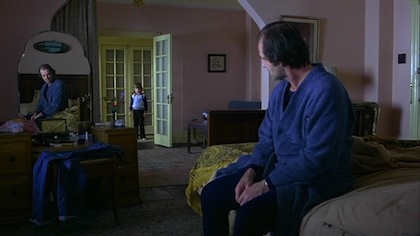 We live under the shadow of the father.
We live under the shadow of the father.At the end of the day, what is a father to his son? Giralt Torrente asks. “Someone who we first try to imitate and from whom we then try to set ourselves apart”, to only discover later on that we are everything that we hated in them.
Oscar Wilde once said, “Don't be discouraged if your children reject your advice. Years later they will offer it to their own offspring”. At bottom, the conflict with the father figure, is the same as our conflict when facing reality: when childhood stories come crumbling down and we discover, horrified, that in life the good people don’t always come out on top.
Then, over the years, we end up accepting an imperfect world, trying to co-exist with our ghosts, even though we keep on trying to find an explanation for the inexplicable.
The doctrine of adoption is fundamental in understanding Christianity. It is when we know that we are God’s children and that He is our Father, that faith becomes a vital reality (John 1:12) that shapes our lives.
The God of the Bible is a Father who has loved us from the very beginning, so that we can be his children (1 John 3:1). There is no other explanation for it other than the affection of his will (Ephesians 1:5).
It is the difference between a slave and a son (Galatians 4:7). We are not his children through obedience, but by his adoption. He is our Father, whatever we may do.
We may dishonour him and bring him shame, but we are his children. This realization– that we have a Father who loves us – should transform our lives.

Las opiniones vertidas por nuestros colaboradores se realizan a nivel personal, pudiendo coincidir o no con la postura de la dirección de Protestante Digital.
Si quieres comentar o